Just like after the first international break, it was Neil Warnock’s Cardiff City that were the first to resume into action after the second international break of the season. On Friday night, they faced Garry Monk’s Sheffield Wednesday who had a chance to go top of the EFL Championship with a victory in South Wales.
Both teams were in touching distance of the play-off spots prior to this game which made the encounter even more intriguing. It was a game of two halves where both teams had a completely contrasting 45 minutes each. The first half certainly belonged to the visitors from Sheffield who had a total of 10 shots compared to the home side’s 3. However, the second half experienced a completely reverse scenario where Cardiff grew into a game producing 11 shots in total. Contrarily, ‘the Owls’ lost the momentum and managed to test the home team’s goalkeeper only twice.
The game ended in a one-all draw that seemed to be a fair result considering the contrast in teams’ performance in both halves. This tactical analysis will take a closer look at both teams’ game strategies that lead to such dissimilar 90 minutes.
Lineups
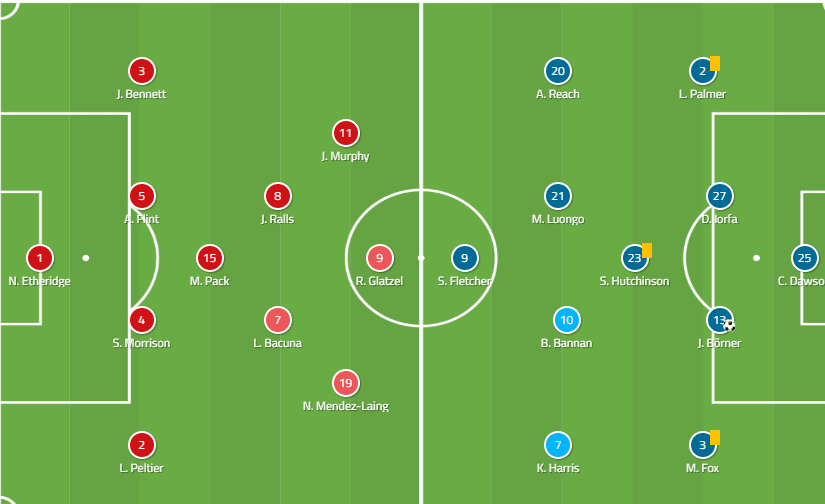
Warnock opted for a 4-3-3 formation in this game. Neil Etheridge returned into the goal following his come back from injury replacing Alex Smithies. He was protected by a back four consisting of Lee Peltier, Sean Morrison, Aden Flint and Joe Bennett. In midfield, it was a solid trio of Marlon Pack, Joe Ralls and Leandro Bacuna who had a more protective role rather than a creative one. Upfront, it was Josh Murphy on the left-wing, Nathaniel Mendez-Laing on the right and Robert Glatzel down the middle.
Monk went for what on paper was a 4-1-4-1 formation. Cameron Dawson started between the sticks with a back four of Liam Palmer, Dominic Iorfa, Julian Börner and Morgan Fox in front of him. Slightly ahead of them was Sam Hutchinson who often dropped in between the two centre-halves to aid the ball progression from the back. The other two more advanced central midfielders were Massimo Luongo and Barry Bannan. The width was provided by two wingers in Adam Reached who roamed on the right and Kadeem Harris on the left. Sheffield Wednesday’s top scorer this season Steven Fletcher started up top.
Sheffield Wednesday’s offensive approach
When in possession, Wednesday took up an approach that is common with the majority of the teams that try to play out from the back. This meant creating numerical superiority when bringing the ball from defence. In this case, it was a holding midfielder Hutchinson who often dropped deep to assist the ball progression. The 30-year-old had the most touches (62) and performed the most passes in a team (47) with an accuracy of 78.7%. It indicated his key role to progress the ball to the next build-up phase.
Below we can see such an example with Hutchinson dropping deep and positioning himself in the backline. The other two central midfielders in Luongo and Bannan situated higher up in more advanced positions. However, as it will be seen later, their positions were not fixed.
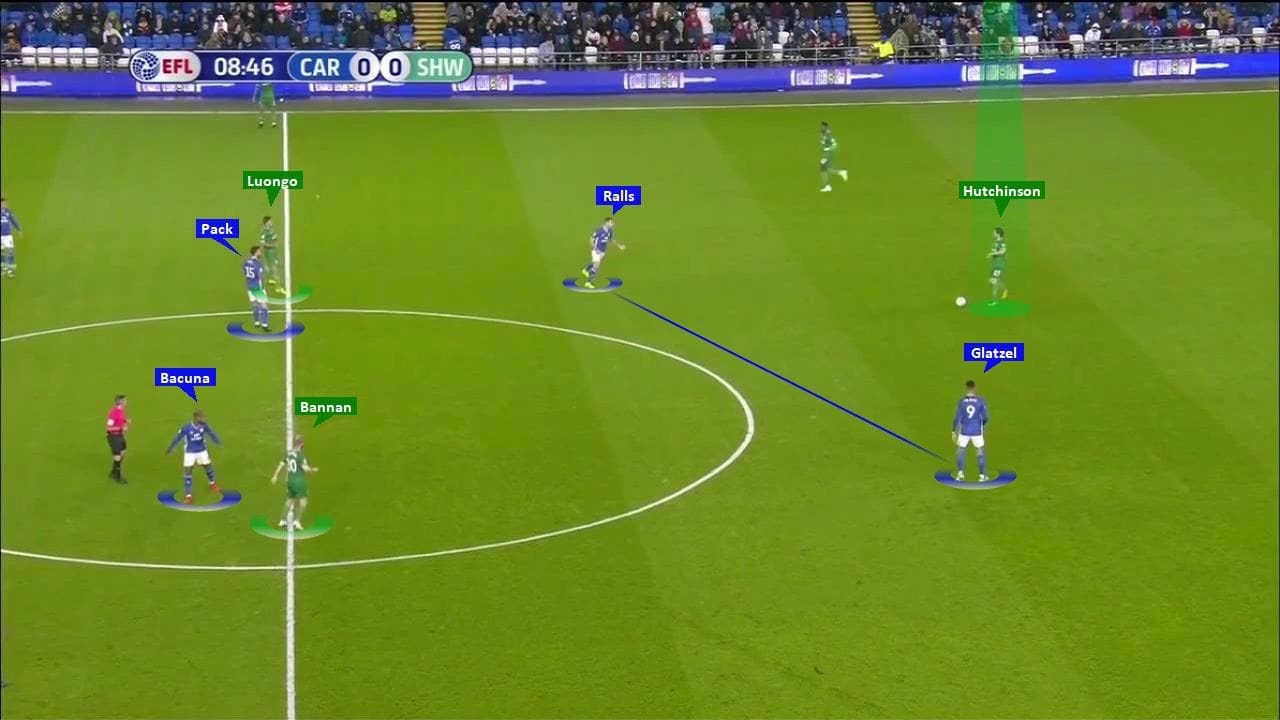
The passing map below confirms Hutchinson’s deep role in this game when distributing the ball. The fairly advanced positions of the two central midfielders Luongo (no.21) and Bannan (no.10) are also evident meaning that they had more licence to roam across the pitch. Furthermore, noteworthy is Hutchinson’s more inclined linkage with the right side of the pitch where Palmer (no.2) and Reach (no.20) played. It is further backed up by the statistics that showed that 44% of Sheffield Wednesday’s attacks came down the right flank.
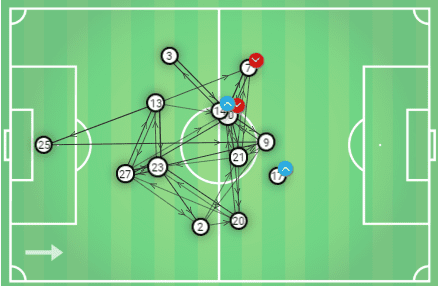
Even though Hutchinson played an important role when Wednesday had the possession of the ball, the real threat came from player rotations and clever movement off the ball.
Sheffield Wednesday’s player rotations came in different forms. The first noticeable manoeuvre was regarding Fletcher’s position and movement during the build-up. The Scotsman on occasions dropped to the halfway line to collect the ball. The intention was to unsettle the opposition’s players by either dragging them out of position or attracting more than one opponent. It means space would open up elsewhere due to Cardiff’s employed man-marking system.
Such an example is illustrated below. Here, Fletcher came to collect the ball in his own half, thus, attracting two Cardiff’s players. Bacuna was man-marking Bannan while a right-winger Reach stayed in a right half-space pinning one of the opponent’s centre-backs. A right-back Palmer took up Reach’s position high on the right-wing and was man-marked by Bennett. Consequently, such tactics created acres of space for Luongo to run into.
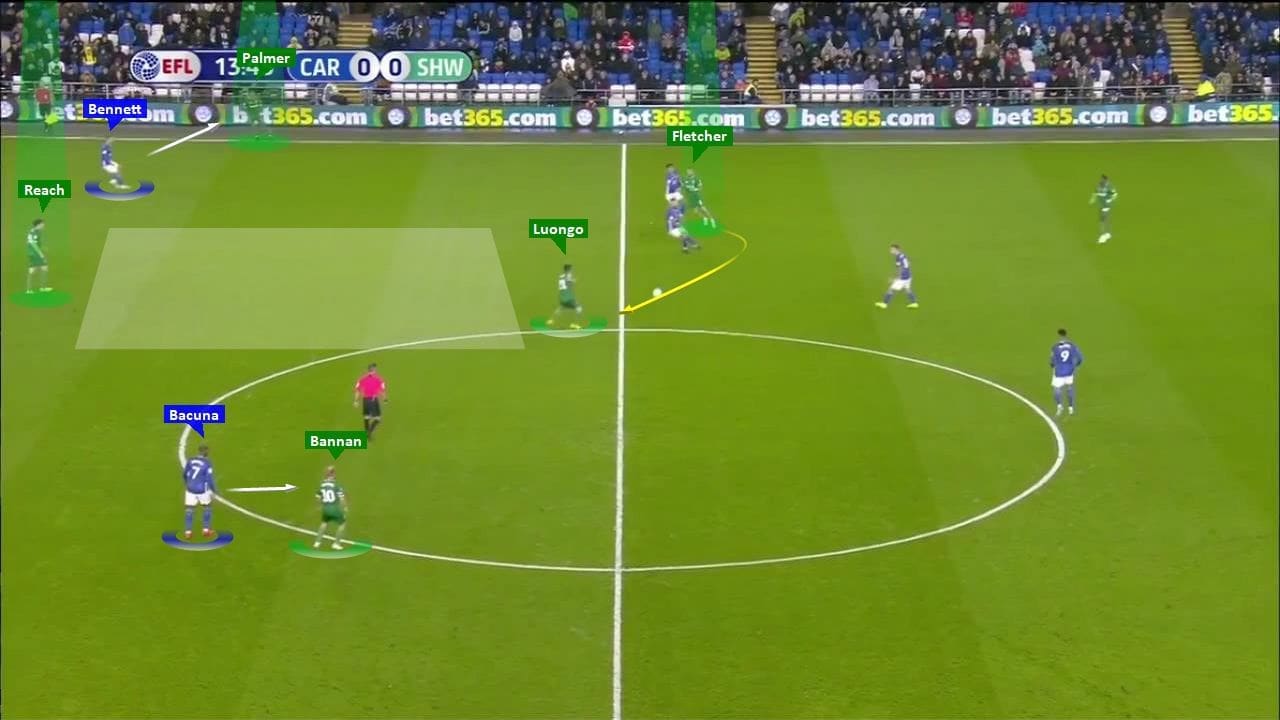
A great deal of Sheffield Wednesday’s attacks came down the right side, thus, overloads and player rotations took place there as well. In the image below, we can see how Monk’s team moved from the first to the second phase of construction using this tactical manoeuvre. The right-back Palmer moves inside and drags the opposition’s left-winger Murphy with himself. Thus, it opens up the passing lane for the centre-back Iorfa who easily finds Reach.
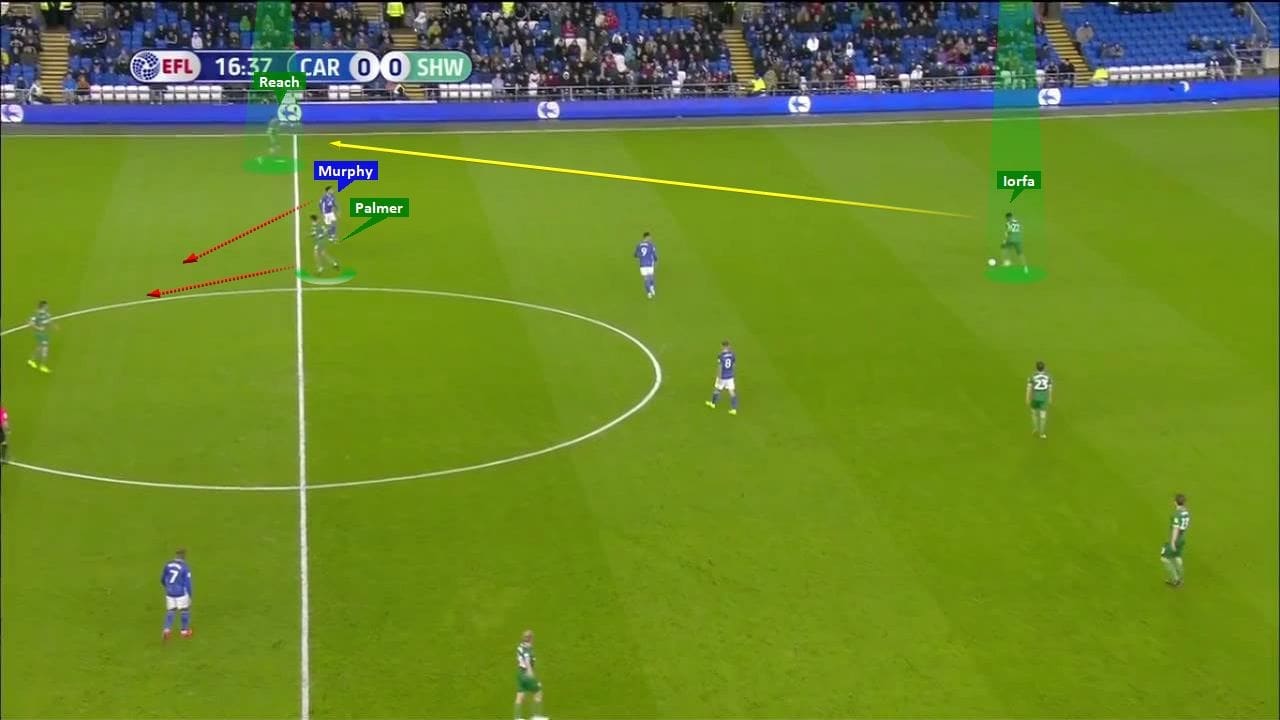
Reach then was closed down by his direct marker Bennett, whereas Palmer ran deeper into the opposition’s half. Murphy tried to stay close to him but as it can be seen lost the right-back from his sight. Additionally, Luongo moved closer towards the ball holder Reach, thus, pulling Pack away and creating more space in the central zone. Fletcher then dropped deeper to receive a pass from Reach in a comfortable position having time to take a touch and turn.
Due to Murphy’s poor positioning, Cardiff’s centre-back Flint was caught in two minds – whether to go with Palmer or step out and close down Fletcher. This temporary two against one numerical advantage enabled Sheffield Wednesday to easily reach the home side’s final third.
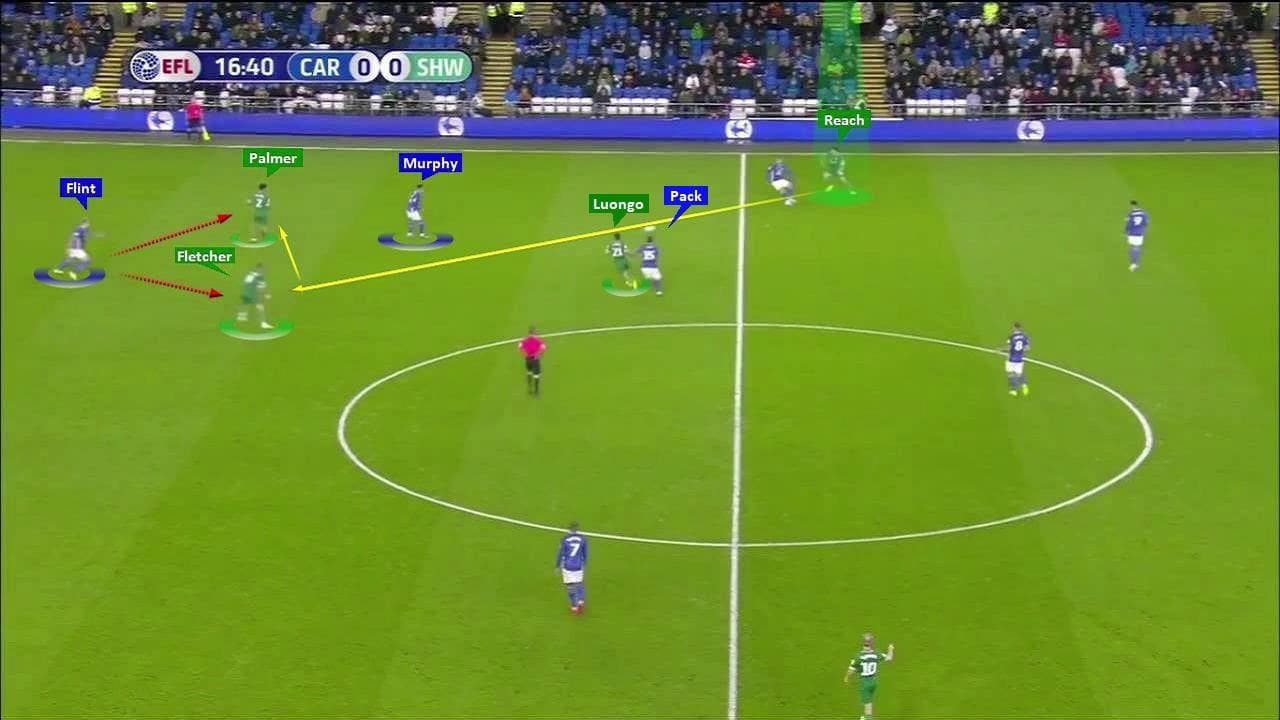
After bypassing the middle third, the visitors usually continued their quick and sharp passing moves around the penalty box as well. They performed a fairly low number of crosses (12) that suggests Monk’s intentions to combine around the box in quick one-two’s.
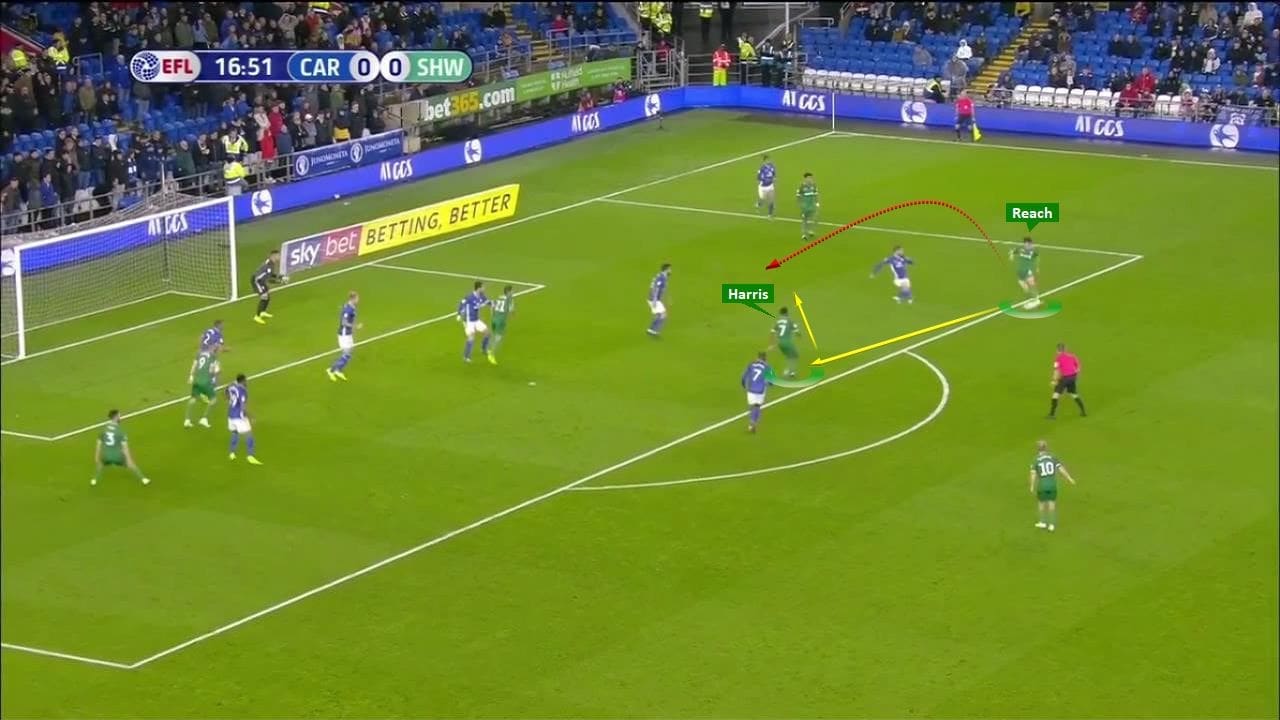
Below is another example of how ‘the Owls’ looked to overload the right side and take advantage of their quick pass and move game. The centre-back Iorfa made a long run all the way to the opposition’s final third down the right side. Palmer combined with an aforementioned Iorfa that meant both Cardiff’s wide players on the right were occupied. Reach acted as a third man running and entered the box with Ralls failing to track him back.
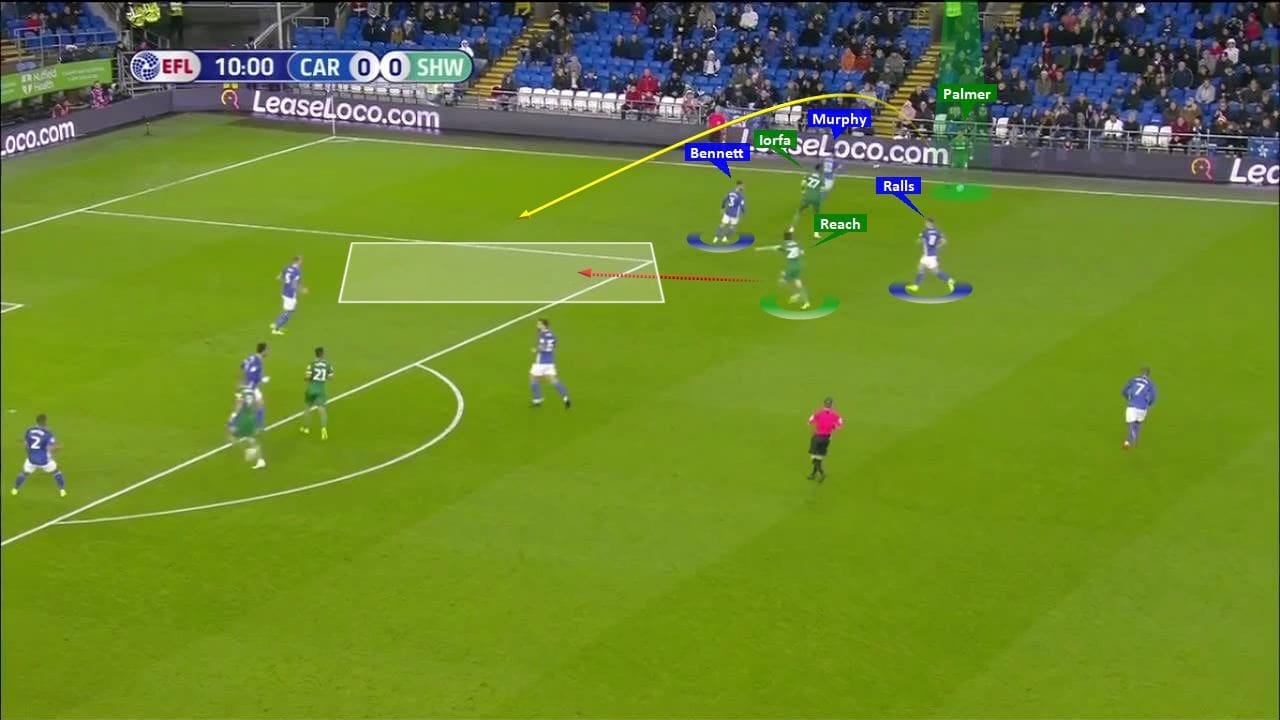
Even though Sheffield Wednesday’s preferred attacking side in this game was right, some player rotations and clever movement of the ball took place on the left as well.
In the picture below, this time we can see Bannan who starts the build-up play for the visitors. Since Cardiff had four players lined-up horizontally near the halfway line, it meant space could be found in behind them. Even more so with the centre-back Flint man-marking Luongo which meant space was in behind him as well. As a result, Luongo shifted across to the left, thus, dragging Flint with himself. Bannan then played a simple ball to the left to Fox.
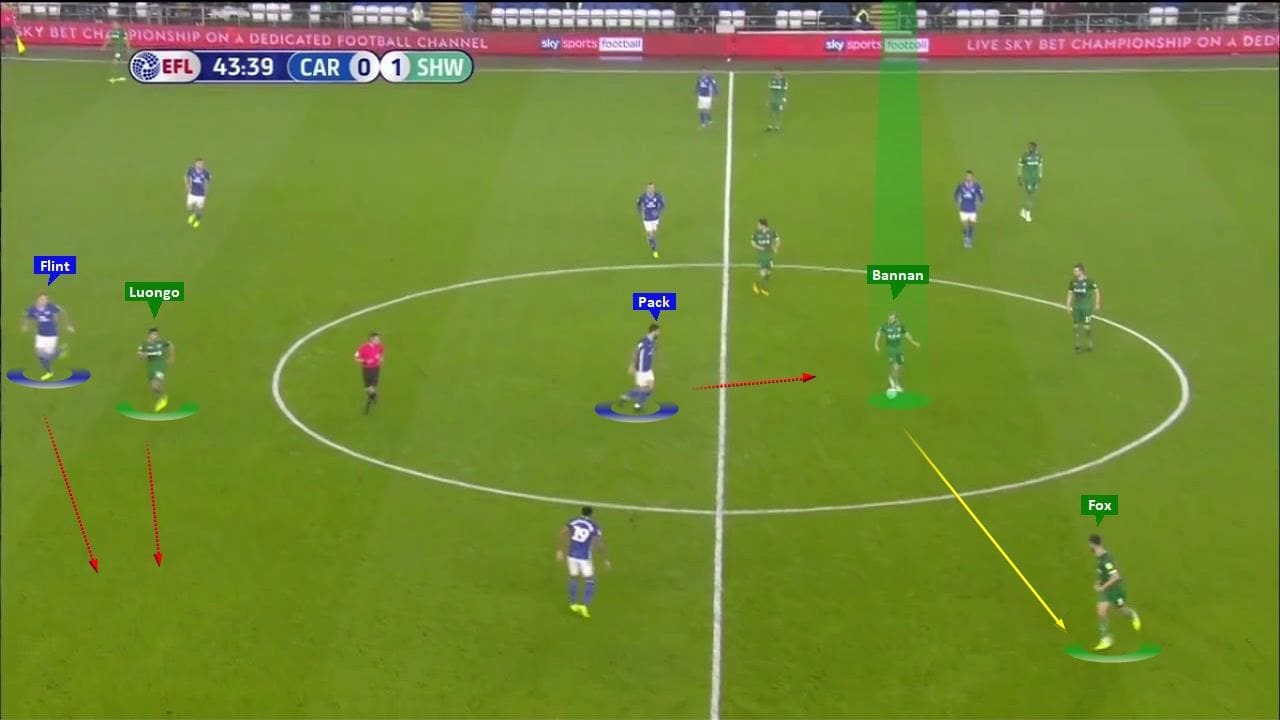
At first, Luongo faked the ball reception and instead started to make a curved run. It dragged Flint even more to the left, thus, creating space for Bannan to run into.
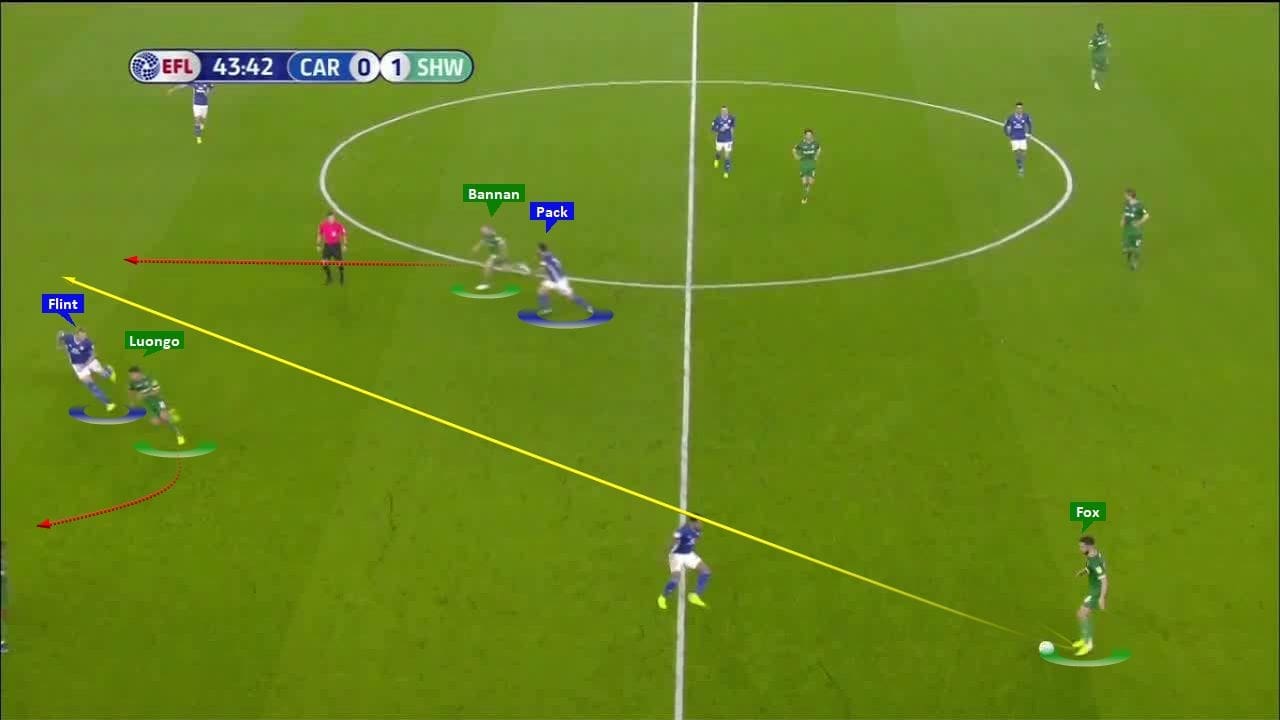
The Aussie midfielder outpaced Cardiff’s centre-back as did Bannan with Pack who were now both in behind the Welsh team defence. It is worth pointing out the position of the left-winger Harris in this situation. As it can be seen at the bottom of the image, he remained deeper which meant his direct marker Peltier was unable to provide cover for Flint and Pack down the left flank.
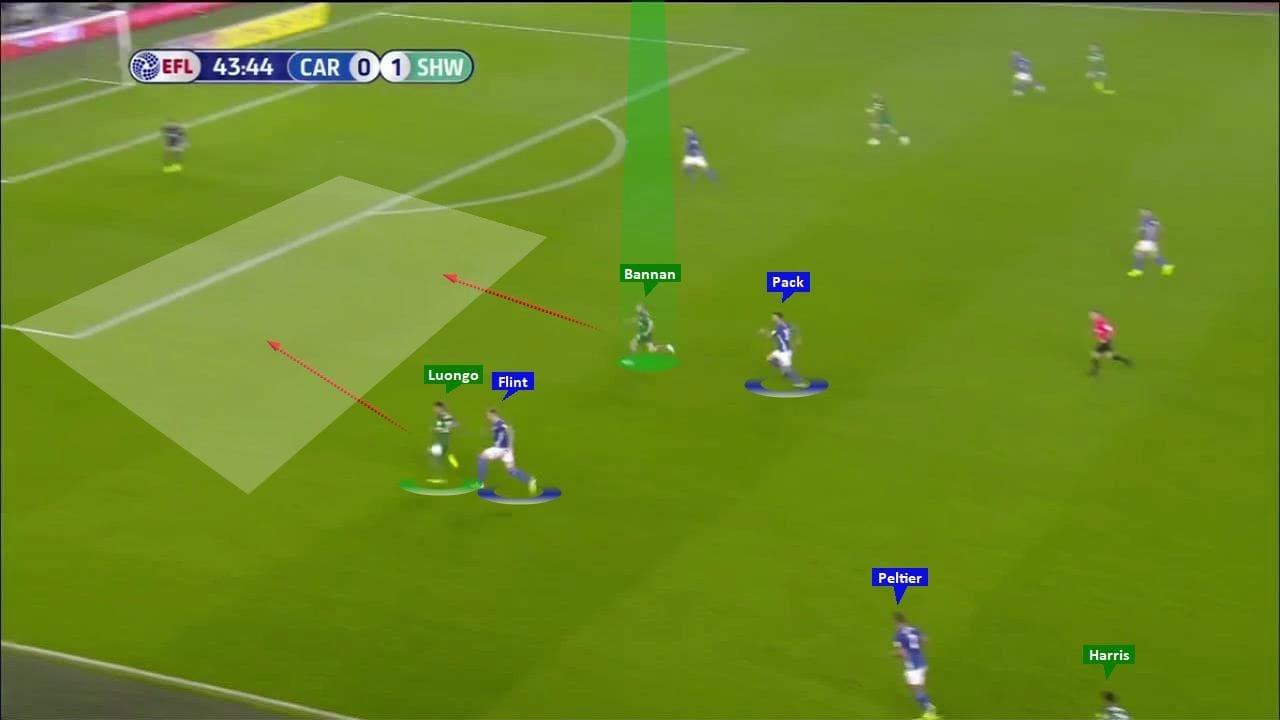
All the highlighted examples were good indications of how Sheffield Wednesday manipulated Cardiff’s man-marking system with clever player rotations and movement.
However, in the second half, the visitors were not able to replicate any of this. Firstly, Monk instructed his team to sit deeper in a low/mid-block and protect the lead. Secondly, Sheffield Wednesday could not gain any momentum due to a high number of fouls they committed (22) that resulted in indirect free-kicks to Cardiff. All those indirect free-kicks meant that Cardiff sent the ball into the box with every opportunity available. As it has been mentioned, it disrupted the visitors’ and lifted the home team’s game.
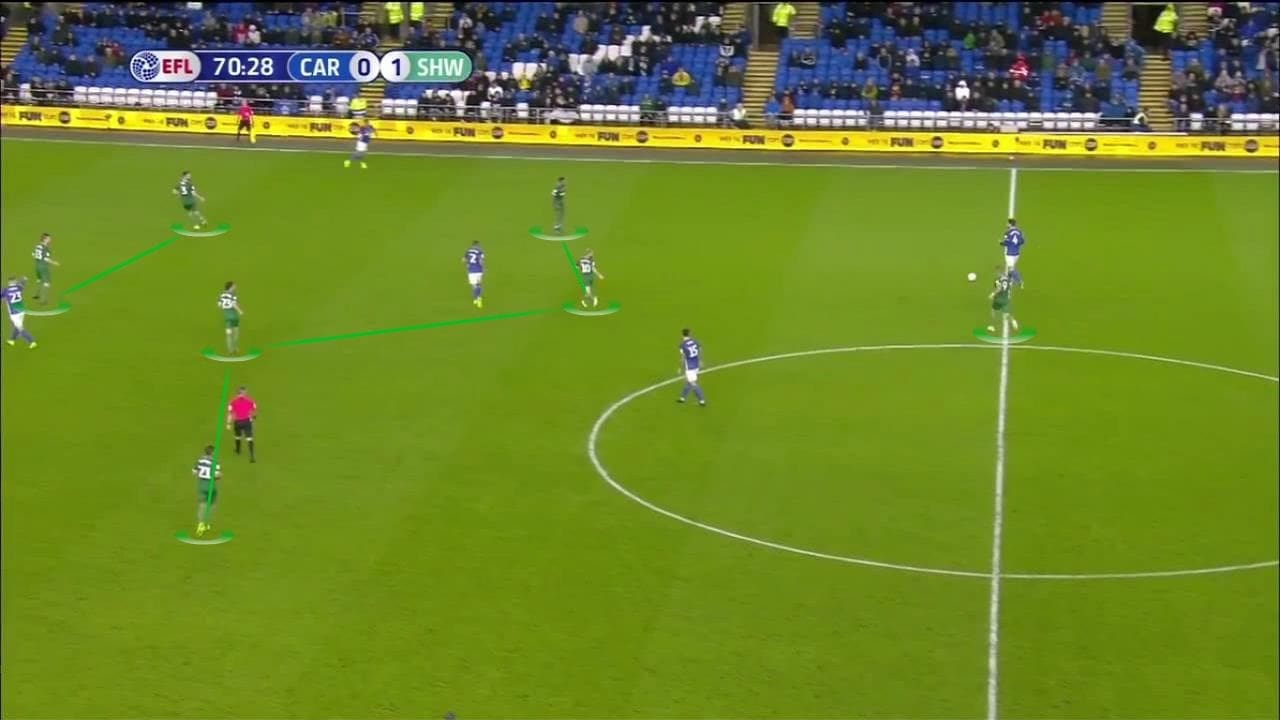
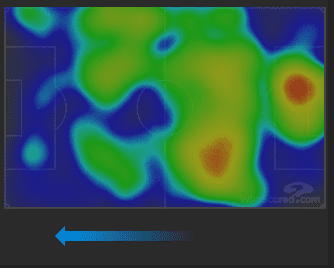
Cardiff’s attacking struggles in the first half
In the first half, Warnock’s team was an equivalent to the Sheffield Wednesday side that we saw for the second 45 minutes. They were cautious and lacked creativity in midfield and attacking areas. A very defensive-minded midfield trio of Pack, Ralls and Bacuna contributed very little in the attacking department. Moreover, Cardiff’s most attacking full-back Bennett had little joy on the left-wing as he was more concerned with his defensive duties. Thus, it made life hard for Murphy who struggled to create space for himself and often found himself congested.
Cardiff City are a counterattacking team that heavily relies on its pacey wingers. Nevertheless, in the first half, neither Murphy nor Mendez-Laing was able to showcase their full potential. In the image below, we can see Murphy on the ball with no-one in the highlighted pocket of space behind the opposition’s line. Bennett (on the left) did not make an overlapping run which meant the only option for the English winger was to send the cross into the box.
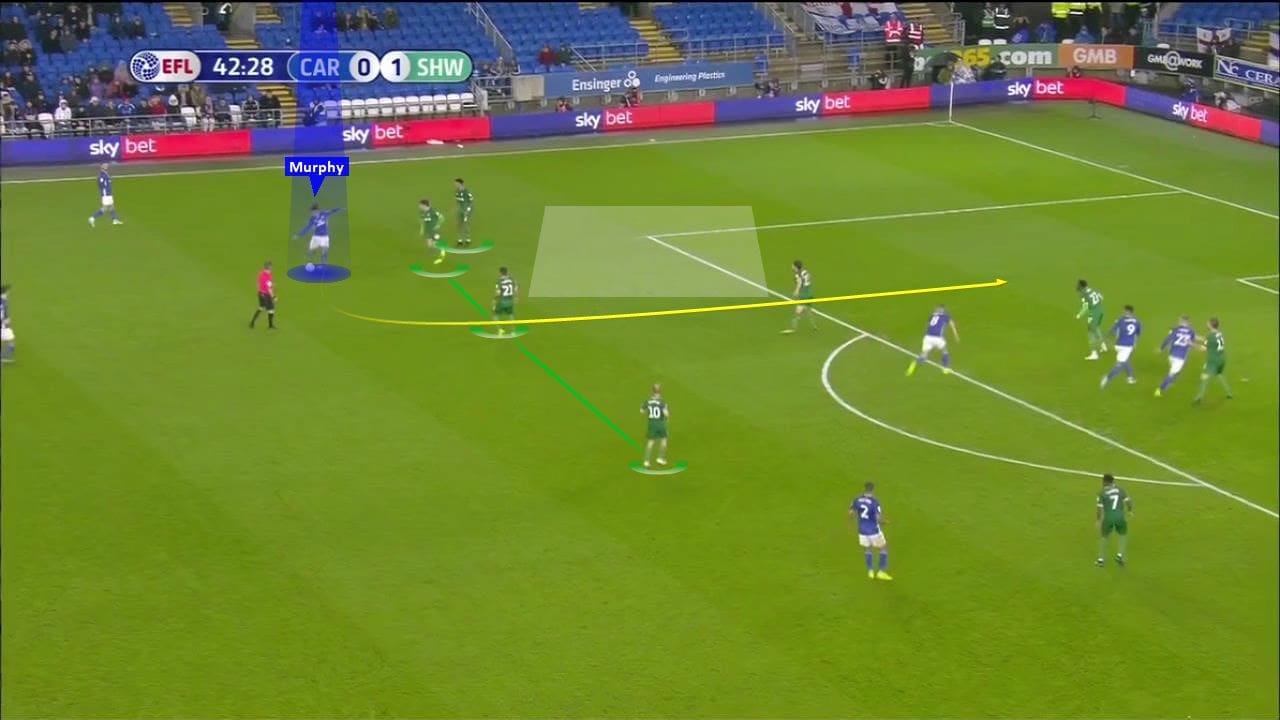
A similar situation can be seen below. This time Murphy had more space in front of him; however, no-one was making an overlapping run on the left again nor trying to run into space behind the opposition’s line. Moreover, there is not a single player to Murphy’s right- hand side to try to play a short combination. Consequently, Cardiff’s winger had to send another hopeless ball into the box searching for isolated Glatzel.
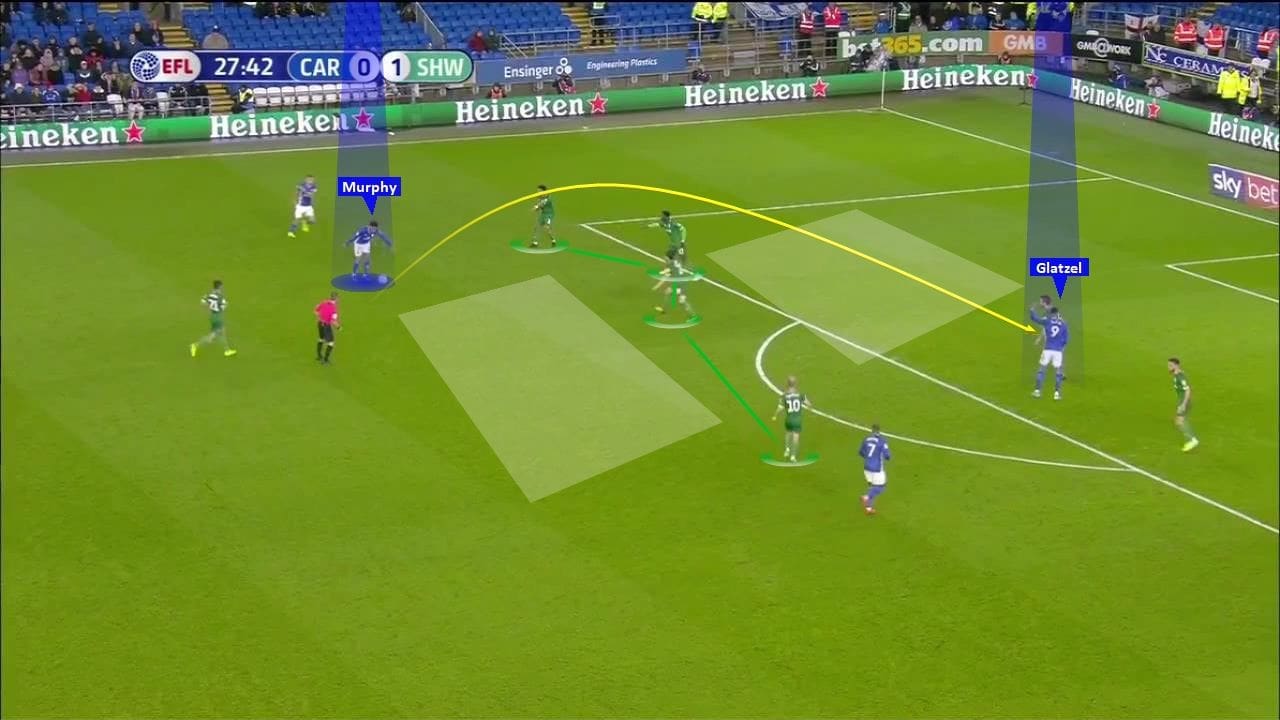
Below, we can find the final illustration displaying Murphy’s and Cardiff’s struggles in the first half. Here again, the English winger has very little space around him that is a nightmare for a player who’s game is based on pace and dribbling. Sheffield Wednesday’s low and compact defensive block congested majority of space; however, lack of movement up front from Cardiff’s players did not help the case. Again, Bennett did not make an overlapping run, whilst Glatzel did not shift across to his right providing a vertical passing option for Murphy. As a result, the left-winger had to play the ball back indicating zero penetration from the home side.
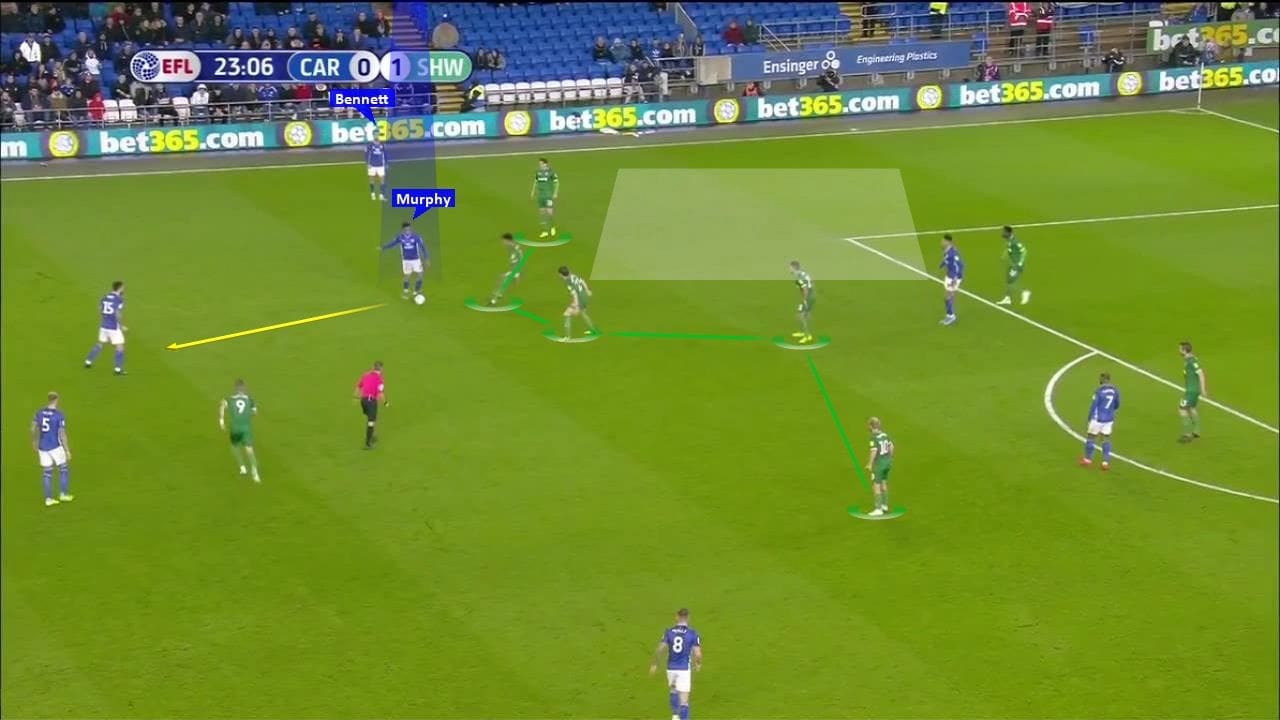
Even though Bennett did join Cardiff’s attack on a few occasions in the first half, in general, he was more concerned with his defensive duties. When the left-back did join the attack, he neither made overlapping runs nor pulled away any of the opposition’s players, thus, creating space for Murphy.
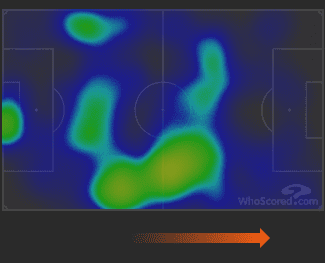
Another problem faced by ‘the Bluebirds’ was the inability to bring Glatzel into the game more often. The opponents did not allow him to receive the ball freely preventing him from laying it off to runners in behind. The German striker completed only five passes in the entire game and lost possession 13 times.
In the image below, we can see how Glatzel was bullied by Sheffield Wednesday players and found it really hard to link-up with his teammates.
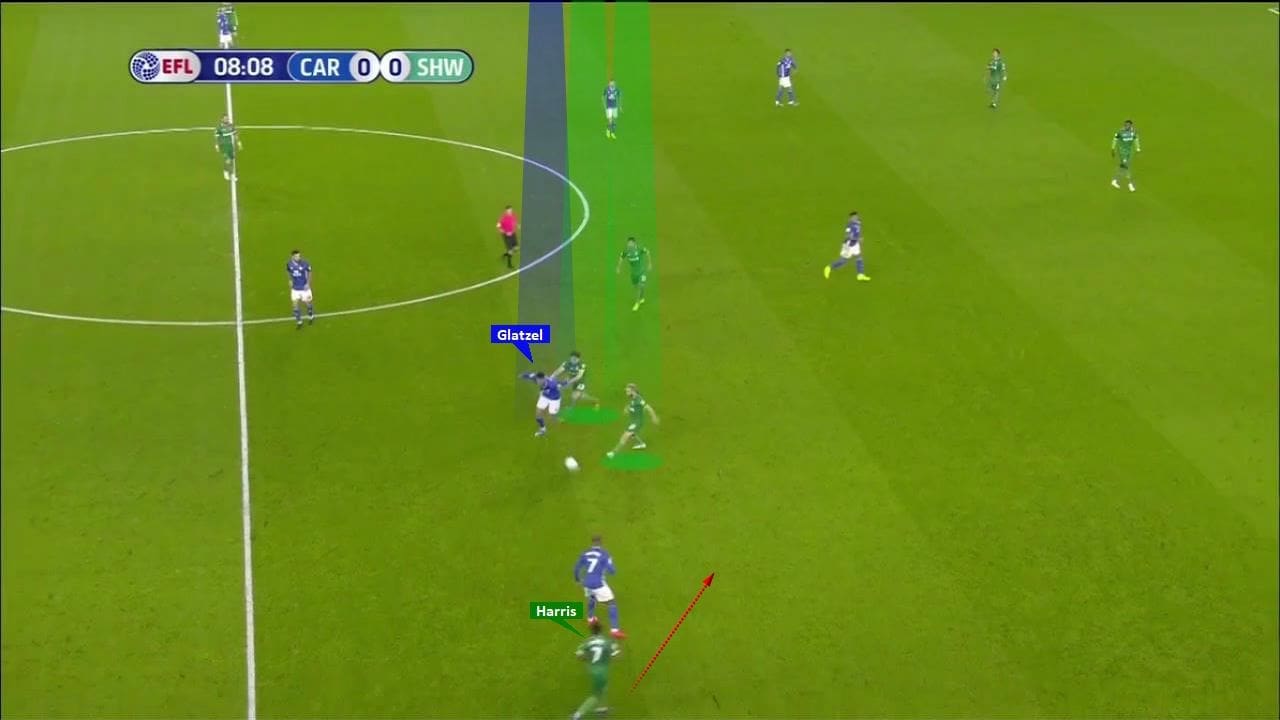
Cardiff’s second-half improvements
After an uneventful and frustrating first 45 minutes for the hosts, the second half saw Warnock’s team a lot more competitive. There were not any magical changes occurring during half-time, the adjustments made by the Cardiff City manager were pretty simple. Firstly, ‘the Bluebirds’ simply committed more players forward. Secondly, Bennett got more involved in the final phase of the attack and thus freed up Murphy on the left to play one against one.
The first scenario of Cardiff sending more bodies forward can be found below. Here, we can see five players of the home team occupying the whole Sheffield Wednesday backline. Warnock’s instructions were to push up onto the opponents and force them back.
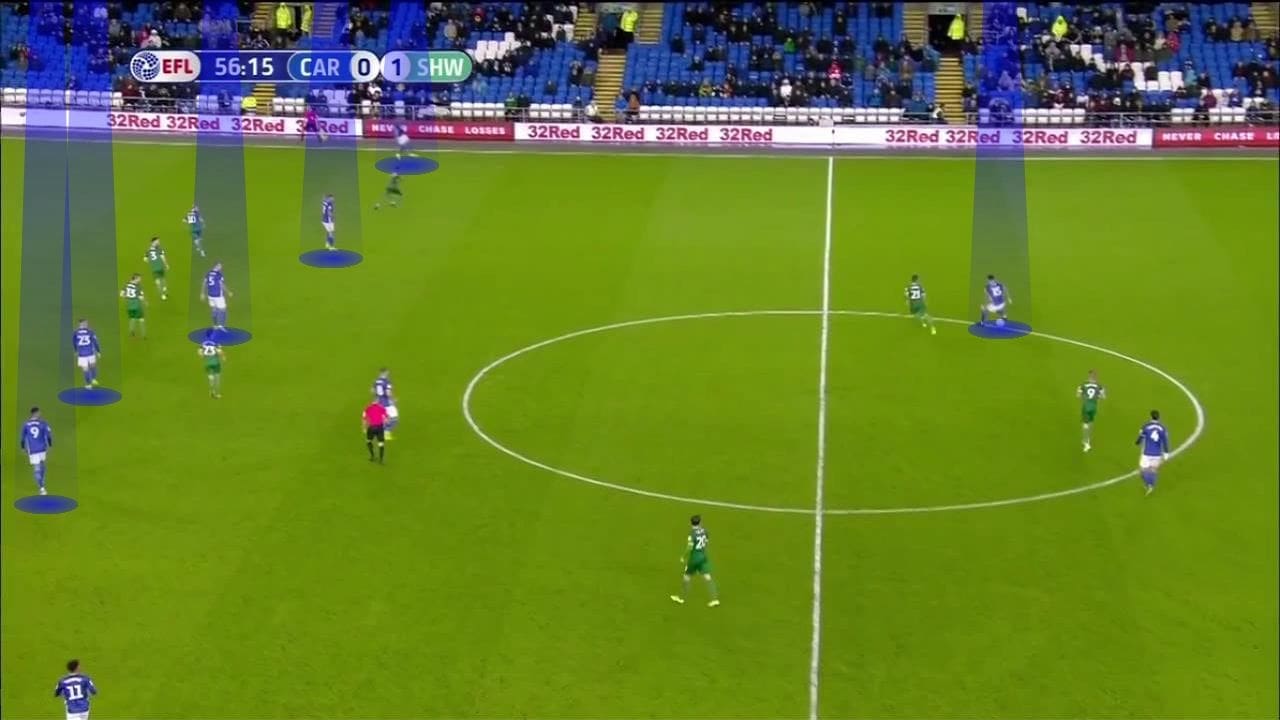
More bodies forward meant that if the ball was successfully switched to one of the flanks, all those players could end up in the penalty box possessing real threat. What is more, more players in the box meant that Sheffield Wednesday had to do exactly the same to avoid numerical inferiority.
Such an example can be found below. Adding to what was mentioned above, it is worth noting Bennett’s positioning in this specific situation. Here, he is found in the penalty area meaning that Wednesday’s right-winger Reach had to keep an eye on him. As a result, Palmer had no support when dealing with Murphy who found himself in more space than in the first half. This allowed Cardiff’s winger to make use of his pace and trickery.
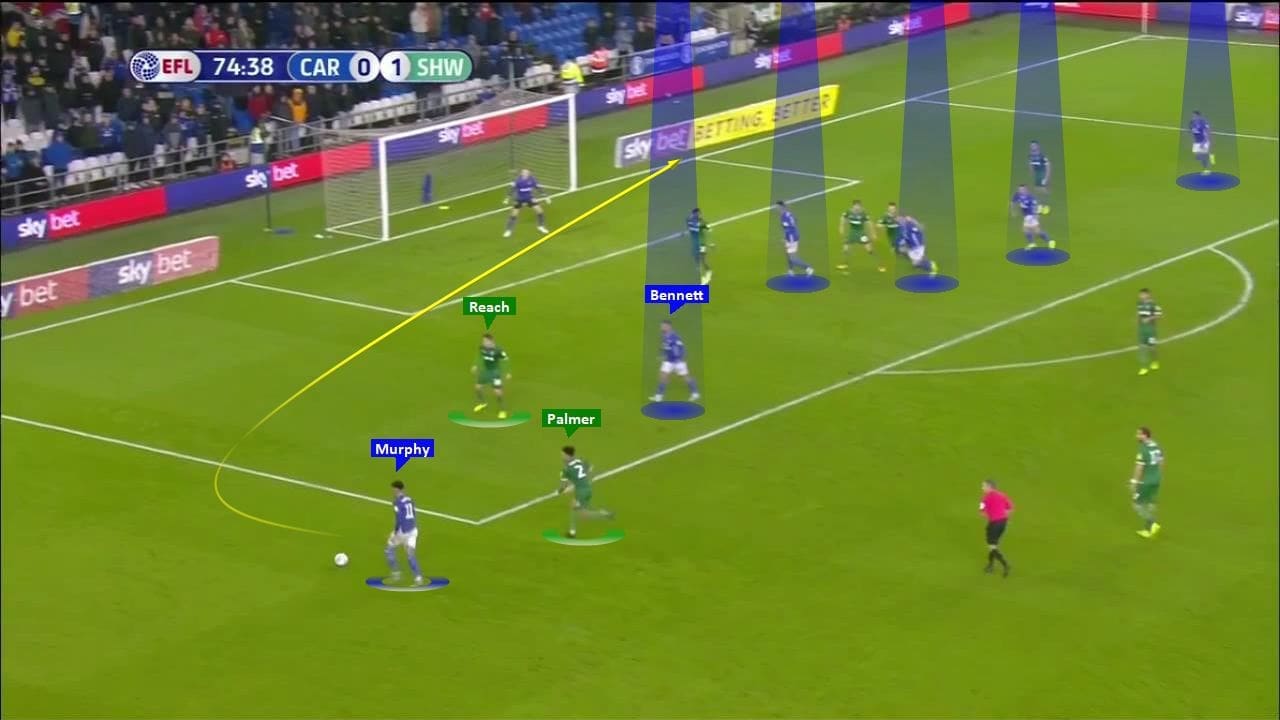
A very similar example is illustrated once again below. Bennett moved inside that meant Reach was unable to help Palmer out who was left one on one with Murphy again. The English winger performed a total of 9 crosses in this game, the most out of all the players. Sadly for Cardiff, only two of them were successful.
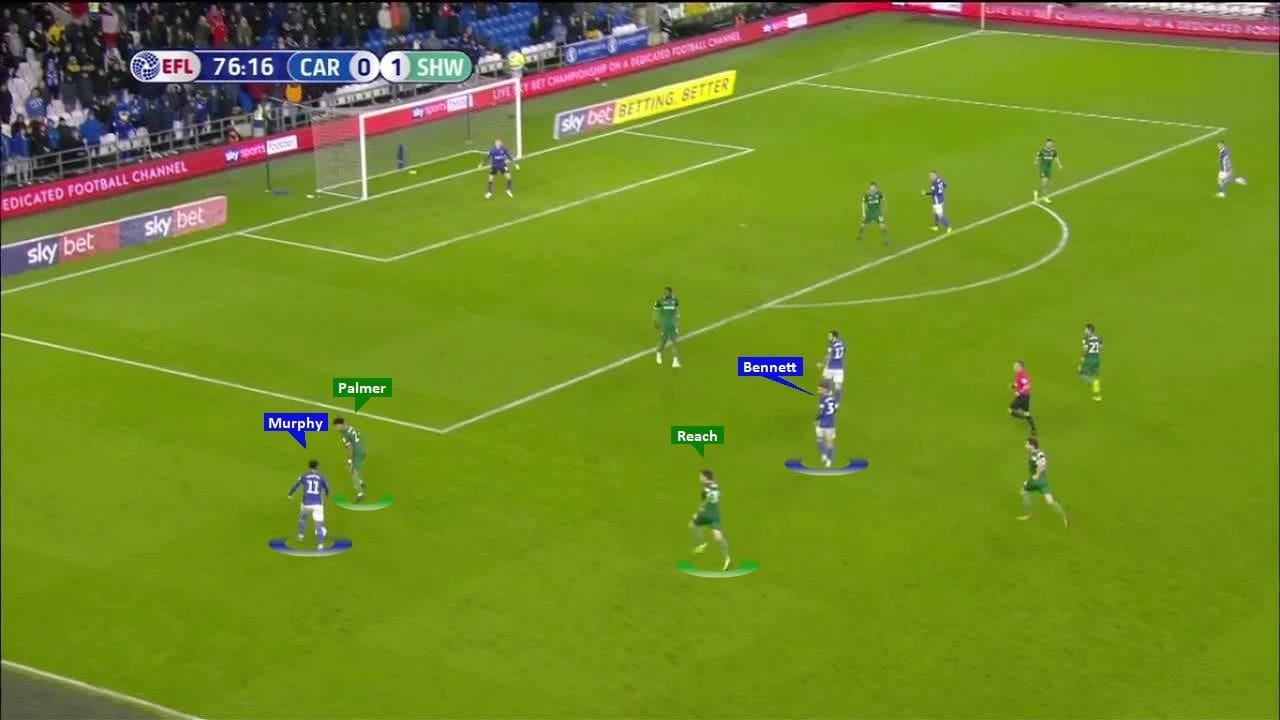
Another key point that has already been mentioned but not highlighted was the fouling of Cardiff’s players. The main victim was Glatzel who was fouled seven times in this game. Every little foul, like the one illustrated below, was a chance for the home team to send the ball into the box. In total, Cardiff performed 79 long balls in a match (35% success rate) of whom 25 were crosses (20% success rate). Even though it put the visitors under a fairly severe amount of pressure, very few of those long balls were actually dangerous. Overall, Sheffield Wednesday won 41 aerial duels on the night, five more than the home team itself.
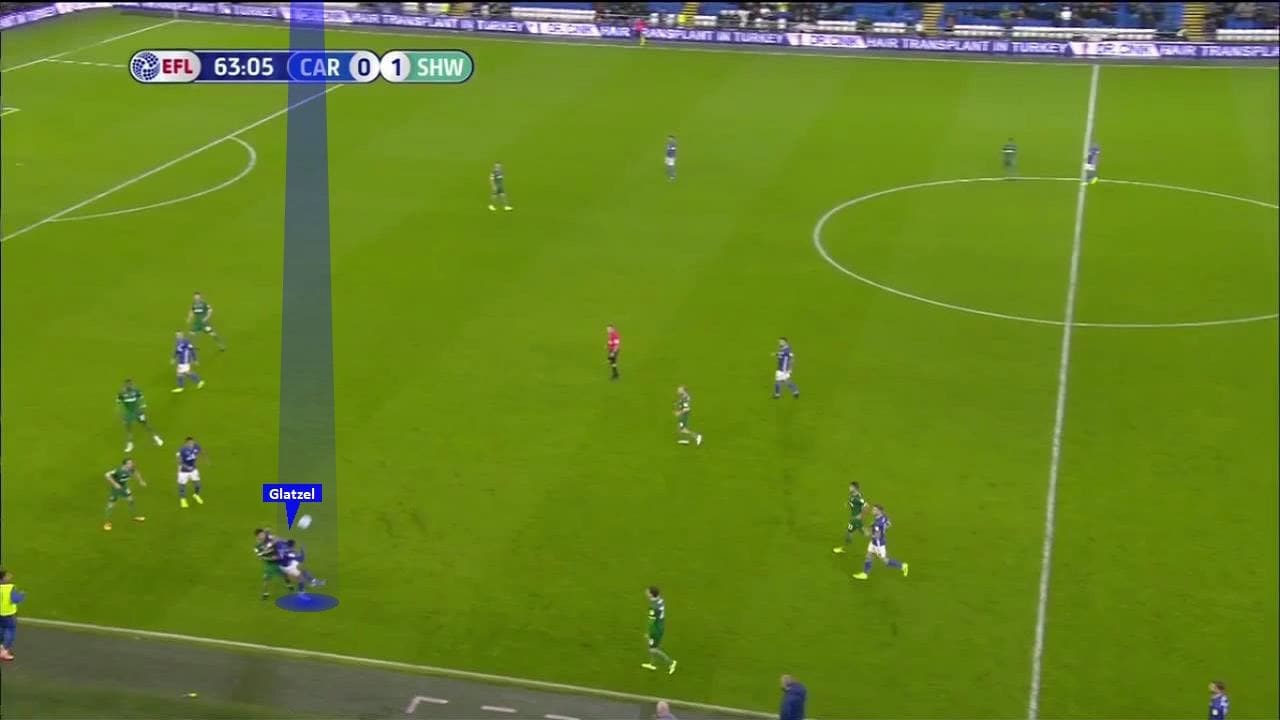
Finally, the moment that led to the equaliser was created by the substitute. Daniel Ward received the ball in front of the Wednesday’s backline who later was fouled just outside ‘the Owls’ box. The free-kick was later beautifully converted by another substitute Lee Tomlin. Ironically, it was in the 86th minute when the visitors tried to put a game to bed after solid and compact defending for the majority of the second half.
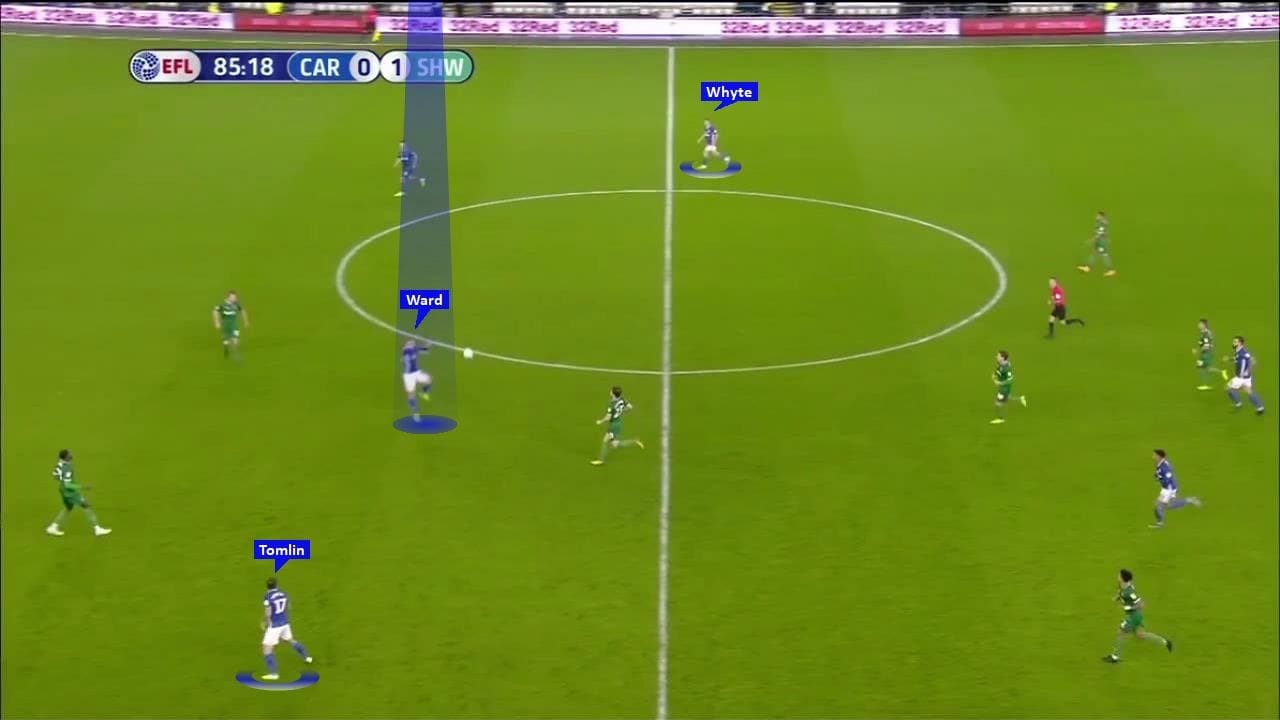
Conclusion
All in all, it was a strange game. As this analysis explained, both teams interchanged the periods of dominance and anonymity. Cardiff City remain unbeaten at home this season while Sheffield Wednesday’s search for the first victory in South Wales has been prolonged once more. Both teams will not have time to grieve with the EFL Championship action returning on Tuesday. Cardiff will travel to Millwall in search of the first away victory this season, whereas Sheffield Wednesday will take on Stoke City at the Hillsborough stadium.

If you love tactical analysis, then you’ll love the digital magazines from totalfootballanalysis.com – a guaranteed 100+ pages of pure tactical analysis covering topics from the Premier League, Serie A, La Liga, Bundesliga and many, many more. Buy your copy of the October issue for just ₤4.99 here





Comments